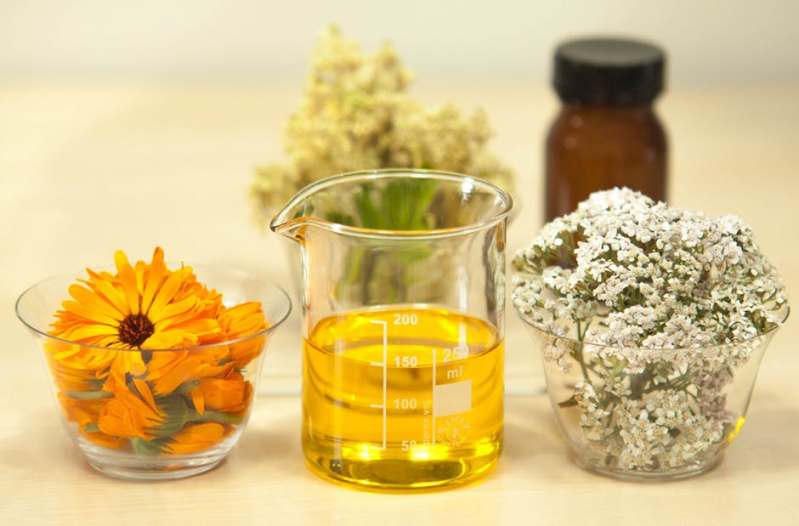
The Benefits
Beard oil can help you with your look as well as with the health of your facial hair and the skin underneath it. Applying a small amount of oil to your beard after a hot shower will help to soften your beard and give you some styling control. The result is a clean look and pleasant smell instead of someone who accidentally dropped a pair of dice and got stuck in an old wooden board game found in the attic — yes I’m referring to Jumanji.
As for health benefits, beard oil moisturizes both your beard hair and the skin underneath it to reduce skin irritation and dandruff. Depending on what essential oils are used, there can be additional benefits such as increased blood flow to your hair follicles or lower blood pressure from stress-reducing aromatherapy.
How it’s Made
At it’s simplest, beard oil has two components: carrier oils and essential oils.
Carrier Oils
Carrier oils are extracted from plants and act as moisturizers when applied to hair and skin. These oils can be extracted from a variety of plants, all of which have different properties that can benefit the body. Some popular oils are jojoba, argan, avocado, and olive oil. These oils, either individually, or as several combined, will make up over 98% of your beard oil. Carrier oils typically do not give off strong smells, but act as the moisturizing and health-infusing base of your beard oil. Teddie makes a solid Jojoba Oil in a 4 0z container for $14, a great size for someone working on their first beard oils.

When choosing carrier oils, be aware of where they come from. There are three methods used to extract carrier oils and are sold accordingly: cold pressed, expelled, and solvent extracted. The latter two methods are least favorable as they use pressure/heat or chemicals, both of which denature oil. Cold pressed oil is extracted using mechanical processes only — grinding and centrifuge — which extracts oil in it’s most natural form. We recommend using cold pressed oils over other options.
Essential Oils
If your beard oil were made up of only carrier oils, you would still have a good product for your beard. Adding essential oils, though, is where beard oil gets good. From pleasing odors to a whole list of supplemental health benefits, you can add essential oils as the finishing 1-2% of your beard oil. Keep in mind, essential oils are very strong and can irritate skin if overly applied. When adding to a beard oil, conservatism is key. A variety pack of essential oils might be the right place to begin. ArtNaturals has a great starter kit that comes with 8 of their top essential oils for $16.

Essential oils are extracted from plants using steam distillation. Trevor Williamson, the founder of Northern Fir Beard Co., shares the detailed process behind essential oil extraction:
“Steam distillation involves placing the part of the plant that has been harvested (seed, kernel, leaf, flower, fruit, etc.) in a chamber through which steam is passed. The steam exits the top of the chamber along with the extracted oil, and the resulting mixture is cooled and condensed, leaving a mixture of oil and water in a collection chamber. The oil, which is lighter than water, floats to the top of the chamber, where it is collected.”
For detailed information about carrier and essential oils and the benefits behind them, see this list compiled by Dr. Axe.
Make It Yourself
To make your own beard oil, you’ll need the proper tools and an experimental spirit.
Tools
We’ve already covered some information about carrier and essential oils. To create your own beard oils, you will need to choose one or many of each oil type to customize your product. What better way to get inspiration than to check out some of the best beard oils out there. To get started, procure at least one carrier oil and a few essential oils to start mixing.
In addition to oils, you will need the proper apothecary glass bottles, measuring pipettes, and labels to experiment with your oils. We did some research and found an ideal starter kit for $14.99. The Royal Green kit includes a ten pack of 1 oz capacity brown glass bottles, two plastic pipettes, and various labels to keep track of your beard oils.

Finally, have a notebook and pen handy to take notes on your experiments and which ones worked best… or least best.
Experiment
At this point, you have at least one carrier oil, a few essential oils, apothecary bottles, a pipette, labels and a notebook. Using these items, along with the scientific method, it’s time to get started! Follow these example steps to make your first beard oil.
- Start with a hypothesis. I’m going to make the best damn beard oil ever.
- Test your hypothesis. Start with 1 oz of carrier oil and add one drop of the essential oil of your choice.
- Is it working? Mix the solution, apply a small amount to an area of your beard/face, wait 5-10 min, make observations.
- Analyze data, compare to hypothesis, make changes. Have you created the best damn beard oil ever? No? Add a second drop of the same or a different essential oil to your solution.
- Repeat. Continue this cycle until you’ve either created a glorious beard oil or you’ve created a monster. Take notes in your notebook so you can recreate or avoid this mixture in the future.
You’ve officially created your very one beard oil! From here, the sky — or mustache — is the limit. Have fun, make a bunch of beard oil, stay away from the attic, and share with friends!


